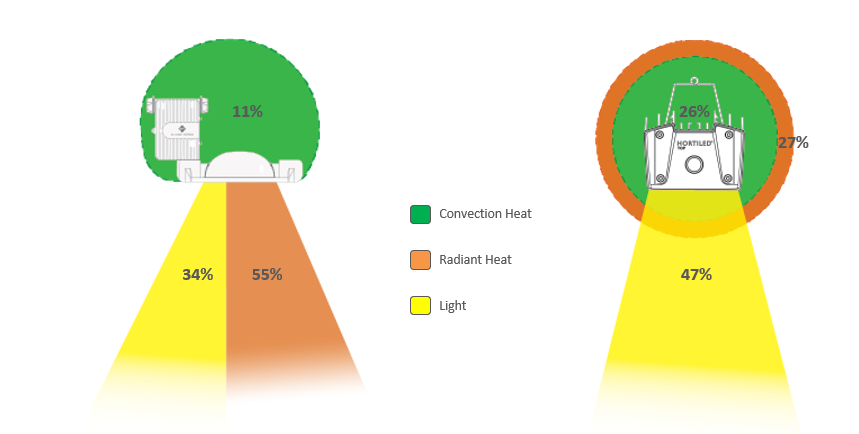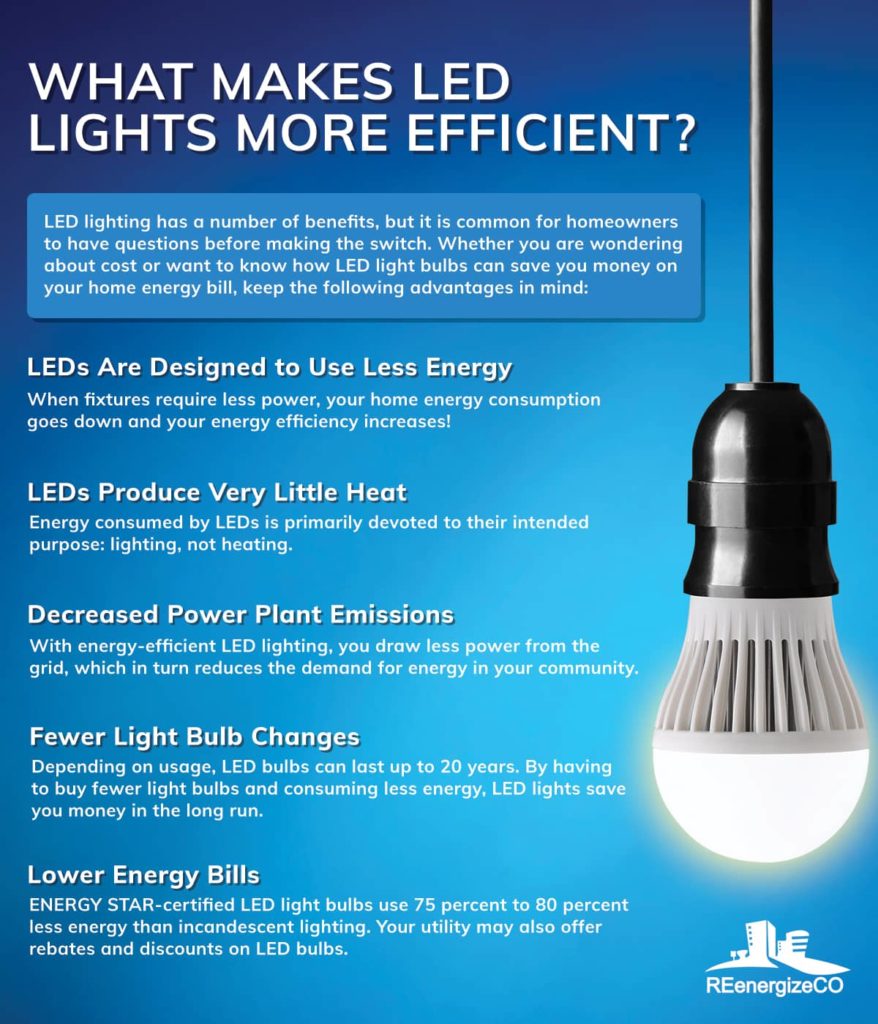Antwort How much heat does LED lights give off? Weitere Antworten – Do LED lights give off much heat
While other light bulbs can get extremely hot when you turn them on, LED lights usually only get slightly warm, if at all (they may even feel cold to the touch). It is because LEDs use less energy than other bulbs, which means they don't waste as much energy producing unnecessary heat.In development and testing, we found that the heatsink of a fully lit LED bulb was around 60°C-100°C (140°F-212°F) depending on the make and model of the LED bulb, room temperature, and airflow.Heat: LEDs emit very little heat. In comparison, incandescent bulbs release 90% of their energy as heat and CFLs release about 80% of their energy as heat. Lifetime: LED lighting products typically last much longer than other lighting types.
How much heat does a 100 watt LED bulb produce : If you have a 100w incandescent bulb, 80% is converted to heat. Now , if you had a LED bulb, and the total amount of power consumed is 100w, and the efficiency is about 50%, then the 100w bulb would produce 50w in light, and 50w in pure heat.
How much heat does a 9W LED bulb produce
A 9W LED bulb may only generate 1/4 as much heat as a 40W incandescent, but that's still a significant amount of heat. If an incandescent bulb would have reached 150C when operating at a 30C ambient temperature, a 9W LED might reach 60C.
Do LED strip lights make your room hot : Yes, LED strip lights will feel warm a little bit and might increase room temperature insignificantly. However, neither they produce noticeable heat nor do they catch fire. Always invest in branded LED strip lights that go through several quality tests.
LED lights do emit a small amount of ultraviolet (UV) radiation, but it is generally considered minimal and within safe limits. UV radiation falls into three categories: UVA, UVB, and UVC.
LED lights boast both safety and environmental benefits. They are devoid of harmful substances like lead and mercury, emit no ultraviolet or infrared rays, and are ecologically friendly. The advanced LED technology eradicates glare and flickering, addressing the visual fatigue that traditional lights often induce.
Do LED light strips make your room hot
Yes, LED strip lights will feel warm a little bit and might increase room temperature insignificantly. However, neither they produce noticeable heat nor do they catch fire.That means that for every 100 watt light bulb, only two of those watts is actually being turned into light. The rest is being turned into heat. In the summer months, using an incandescent light bulb is not only going to heat up a room faster, but it is also going to cost more energy.The higher the wattage of a light bulb, the more heat it will produce. A 60-watt bulb can get up to 200 degrees Fahrenheit on the bulb's glass surface. A 40-watt bulb can reach temperatures over 100 degrees Fahrenheit.
roughly 4,600º F
The filament's temperature is very high, generally over 2,000º C, or 3,600º F. In a "standard" 60-, 75-, or 100-Watt bulb, the filament temperature is roughly 2,550º C, or roughly 4,600º F.
Is it OK to leave LED strip lights on all night : Yes, it is generally safe to leave an LED strip light on constantly. LED lights are designed to be energy-efficient and generate very little heat compared to traditional lighting sources. However, it's always a good idea to follow manufacturer recommendations and guidelines regarding usage and safety precautions.
Is it bad to leave LED strip lights on overnight : There's no reason not to leave your LED strip lights on all night, as long as they're not too bright and you don't have any neighbors who complain about the noise. If these things are important to you, then by all means keep them on for 24/7!
Are LED lights safe for bedroom
By paying attention to the LED bulb specifications, and taking appropriate precautions and using some basic common sense, you can safely incorporate LED lights in your home without any negative health effects of the "blue light hazard."
LED bulbs are thought to be safer than UV bulbs, as they transmit weaker rays. With prolonged exposure to LED light (vs. UV light), it is considered not as hazardous, as for example with excessive tanning, which can darken the skin and may lead to skin cancer with prolonged exposure to the sun's UV rays.Having bright lights on all night long can disrupt your natural circadian rhythms and make it harder to fall and stay asleep. The blue light emitted from LEDs is especially problematic for sleep. Consider turning strip lights off in bedrooms and living spaces at night.
Where should you not use LED lights : LEDs deal with heat much differently than other bulbs. They use a heat sink to draw heat away from the diodes, as excessive heat can cause the bulb to fail. This problem is exacerbated when an LED light is installed in a ventless enclosed fixture.





